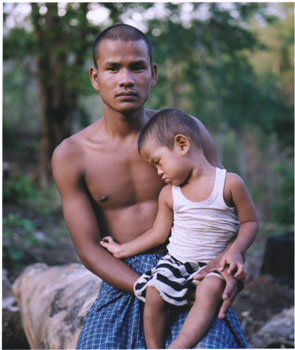"Burma is a golden land, the richest country in Asia, the envy of its neighbors; its people are the kindest, most hospitable on earth," says Amitav Ghosh in his afterword to Burma: Something Went Wrong, Chan Chao’s acclaimed book documenting his trips to his native country. With his art, Chao puts a face to one of the most troubled and least understood countries of our world. While Burma (now Myanmar) is a nation in violent conflict, Chao’s technique is to create a portrait featuring the refugees, pro-democracy insurgents, soldiers and others who populate the country, against the lush, colorful, fragrant backdrop of what is undoubtedly a beautiful country. The juxtaposition informs the viewer, that this is region, although in constant turmoil, is still a "golden land."
Chao, 34, immigrated to the United States with his family at age 12 and attended school in Prince George's and Montgomery counties, eventuallybecoming a student at the University of Maryland. One of his professors, John Gosage, introduced him to fine art photography.
Portraits and studio work were Chao's specialty. In an exhibition space behind the Burma portraits is an installation of some of his earlier work, edgy black-and-white nudes, images a world apart from those ofthe refugee camps. Although the damaged bodies and faces in the exhibit's small color portraits attest to the fact that the camps can be hazardous, Chao said he never felt endangered. He went to meet relatives, not take pictures, he said.
Ultimately, though, his motive was introspective: self-discovery. "I only felt I wanted to go back when I was turning about 30," he said. "I started to reexamine myself and ask, 'Who am I? What's my background?' " So, in 1996, he bought a ticket, applied for a visa and was given aresounding "No" from the embassy of Burma, also known as Myanmar. The reason, he said, is that his father supports the democracy movement there. Chao used his ticket to visit friends in Asia instead, figuring that he'd try Burma again when he was closer.
He did, this time from Jakarta, and still couldn't obtain a visa. "I was crushed," he said. A friend in Thailand offered to help, and at least Thailand was closer to Burma. "That's when I decided to go to the border," he said. "Since I was this close, I might as well try to getsome experience of going back to Burma."
Civil unrest has plagued Burma since its independence from Britain in the 1940s, and the border is riddled with refugee camps. As Chao's photos attest, the camps are multiethnic and multigenerational. People in them wear sarongs, fatigues, polo shirts; they hold guitars, guns, children. It's an existence marked by grindingly prosaic concerns and a twilight uncertainty.
Chao revisited the Thai-Burma border in 1997 and went to the India-Burma border in 1998. The Indian border was more remote, harder to reach and in the middle of its own ethnic battles. Chao felt he had to go there, he said, because it was the closest point, geographically, to the part of Burma his family came from.
The photographer credits the Burmese government with launching the project: "Had they given me a visa, I don't think I would have gotten involved so politically. I would have been more of a tourist."










Questions:
- How would you compare Chan Chao's work to the work of Rienke Dijkstra, from Ch. 3? How is it similar, how is it different?
- What do you think of the relationship between the images and the title of the series, "Burma- Something Went Wrong?"
- Why do you think Chan's inability to get a legitimate visa effected his choice of how to photograph?

4 comments:
I think not getting a visa changed Chan's mindset. As he said, if he had gotten one he would of been there as a tourist and probably would have photographed things in a snapshotty-photo album kind of way. Instead I think his photographs have a very documentary look to them.
I think these images are very powerful because of the connection that the artist has with the people. I think it would be comlpetely different if they were photographs taken by someone who had no connection, who had no interest or concern in the people. At first they did remind me of Dijkstra's work, just because of the way the people are positioned in the same general area, but I think they have very different meanings.
You can see in these protraits that these poeple used to have more than they have now. The shot with the man in the boxing gloves says alot. Maybe he used to be an athlete, maybe he used to afford leisure time. Dijkstra's work is similar in arrangement, but i think Chao's work has more serious political undertones, considering the background behind the series. The denial of a visa seems to have set off a political rightousness in the artist.
I think that the title something went wrong, in connection with the images, makes you look at the pictures and know that this is not the way the people of Burma would want to be living. That this is a window into a world that should have been different, better.
Post a Comment